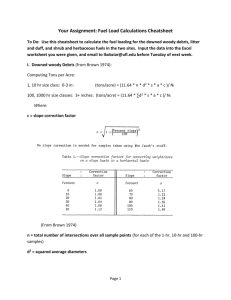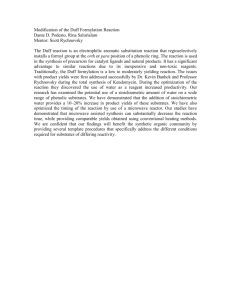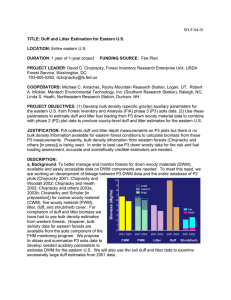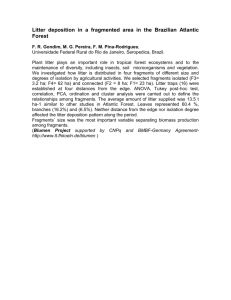David C. Chojnacky , Michael C. Amacher , and Charles H. Perry 1
advertisement
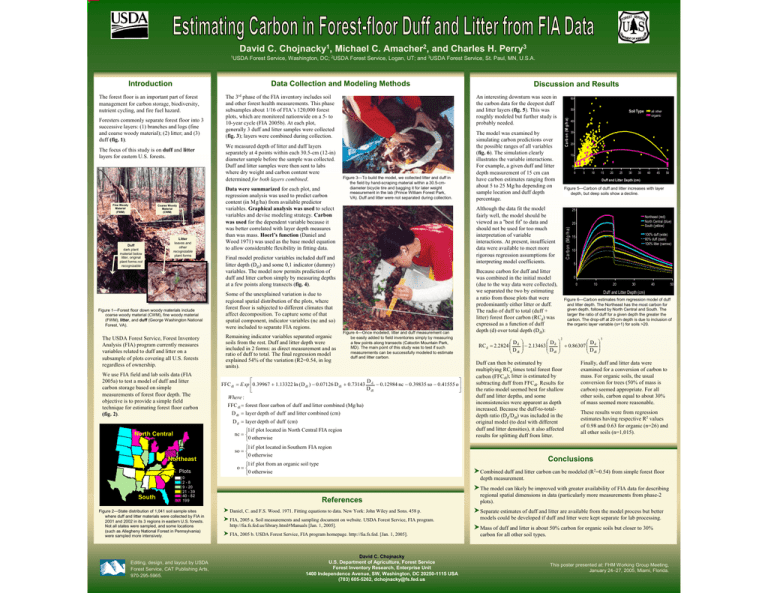
David C. Chojnacky1, Michael C. Amacher2, and Charles H. Perry3 Data Collection and Modeling Methods The forest floor is an important part of forest management for carbon storage, biodiversity, nutrient cycling, and fire fuel hazard. Foresters commonly separate forest floor into 3 successive layers: (1) branches and logs (fine and coarse woody material); (2) litter; and (3) duff (fig. 1). The focus of this study is on duff and litter layers for eastern U.S. forests. Fine Woody Material (FWM) Coarse Woody Material (CWM) Litter leaves and other recognizable plant forms Duff dark plant material below litter, original plant forms not recognizable Figure 1—Forest floor down woody materials include coarse woody material (CWM), fine woody material (FWM), litter, and duff (George Washington National Forest, VA). The USDA Forest Service, Forest Inventory Analysis (FIA) program currently measures variables related to duff and litter on a subsample of plots covering all U.S. forests regardless of ownership. We use FIA field and lab soils data (FIA 2005a) to test a model of duff and litter carbon storage based on simple measurements of forest floor depth. The objective is to provide a simple field technique for estimating forest floor carbon (fig. 2). The 3rd phase of the FIA inventory includes soil and other forest health measurements. This phase subsamples about 1/16 of FIA’s 120,000 forest plots, which are monitored nationwide on a 5- to 10-year cycle (FIA 2005b). At each plot, generally 3 duff and litter samples were collected (fig. 3); layers were combined during collection. We measured depth of litter and duff layers separately at 4 points within each 30.5-cm (12-in) diameter sample before the sample was collected. Duff and litter samples were then sent to labs where dry weight and carbon content were determined for both layers combined. Data were summarized for each plot, and regression analysis was used to predict carbon content (in Mg/ha) from available predictor variables. Graphical analysis was used to select variables and devise modeling strategy. Carbon was used for the dependent variable because it was better correlated with layer depth measures than was mass. Hoerl’s function (Daniel and Wood 1971) was used as the base model equation to allow considerable flexibility in fitting data. Figure 3—To build the model, we collected litter and duff in the field by hand-scraping material within a 30.5-cmdiameter bicycle tire and bagging it for later weight measurement in the lab (Prince William Forest Park, VA). Duff and litter were not separated during collection. Some of the unexplained variation is due to regional spatial distribution of the plots, where forest floor is subjected to different climates that affect decomposition. To capture some of that spatial component, indicator variables (nc and so) were included to separate FIA regions. Figure 4—Once modeled, litter and duff measurement can be easily added to field inventories simply by measuring a few points along transects (Catoctin Mountain Park, MD). The main point of this study was to test if such measurements can be successfully modeled to estimate duff and litter carbon. ⎡ ⎤ D FFC dl = E xp ⎢0.39967 + 1.13322 ln ( D dl ) − 0.07126 D dl + 0.73143 d − 0.12984 nc − 0.39835 so − 0.41555 o ⎥ D dl ⎣ ⎦ Where : FFC dl = forest floor carbon of duff and litter combined (Mg/ha) D dl = layer depth of duff and litter combined (cm) D d = layer depth of duff (cm) ⎧1 if plot located in North Central FIA region nc = ⎨ ⎩0 otherwise North Central Northeast Plots South 0 2-8 9 - 20 21 - 39 40 - 82 199 Figure 2—State distribution of 1,041 soil sample sites where duff and litter materials were collected by FIA in 2001 and 2002 in its 3 regions in eastern U.S. forests. Not all states were sampled, and some locations (such as Allegheny National Forest in Pennsylvania) were sampled more intensively. Editing, design, and layout by USDA Forest Service, CAT Publishing Arts, 970-295-5965. 60 50 The model was examined by simulating carbon predictions over the possible ranges of all variables (fig. 6). The simulation clearly illustrates the variable interactions. For example, a given duff and litter depth measurement of 15 cm can have carbon estimates ranging from about 5 to 25 Mg/ha depending on sample location and duff depth percentage. ⎧1 if plot located in Southern FIA region so = ⎨ ⎩0 otherwise ⎧1 if plot from an organic soil type o= ⎨ ⎩0 otherwise References 6 Daniel, C. and F.S. Wood. 1971. Fitting equations to data. New York: John Wiley and Sons. 458 p. 6 FIA, 2005 a. Soil measurements and sampling document on website. USDA Forest Service, FIA program. http://fia.fs.fed.us/library.html#Manuals [Jan. 1, 2005]. 6 FIA, 2005 b. USDA Forest Service, FIA program homepage. http://fia.fs.fed. [Jan. 1, 2005]. David C. Chojnacky U.S. Department of Agriculture, Forest Service Forest Inventory Research, Enterprise Unit 1400 Independence Avenue, SW, Washington, DC 20250-1115 USA (703) 605-5262, dchojnacky@fs.fed.us ⎛D ⎞ ⎟⎟ − 2.13463 ⎜⎜ d ⎝ D dl ⎠ all other organic 30 20 0 0 5 10 15 20 25 30 35 40 45 50 Duff and Litter Depth (cm) Figure 5—Carbon of duff and litter increases with layer depth, but deep soils show a decline. 25 Northeast (red) North Central (blue) South (yellow) 20 100% duff (wide) 60% duff (dash) 100% litter (narrow) 15 10 5 Because carbon for duff and litter was combined in the initial model (due to the way data were collected), we separated the two by estimating a ratio from those plots that were predominantly either litter or duff. The radio of duff to total (duff + litter) forest floor carbon (RCd) was expressed as a function of duff depth (d) over total depth (Ddl): ⎛D RC d = 2.2824 ⎜⎜ d ⎝ D dl Soil Type 40 10 Although the data fit the model fairly well, the model should be viewed as a “best fit” to data and should not be used for too much interpretation of variable interactions. At present, insufficient data were available to meet more rigorous regression assumptions for interpreting model coefficients. Final model predictor variables included duff and litter depth (Ddl) and some 0,1 indicator (dummy) variables. The model now permits prediction of duff and litter carbon simply by measuring depths at a few points along transects (fig. 4). Remaining indicator variables separated organic soils from the rest. Duff and litter depth were included in 2 forms: as direct measurement and as ratio of duff to total. The final regression model explained 54% of the variation (R2=0.54, in log units). Discussion and Results An interesting downturn was seen in the carbon data for the deepest duff and litter layers (fig. 5). This was roughly modeled but further study is probably needed. C arb on (M g/ha) Introduction Forest Service, Washington, DC; 2USDA Forest Service, Logan, UT; and 3USDA Forest Service, St. Paul, MN, U.S.A. C a rb o n (M g /h a ) 1USDA 0 0 10 20 30 40 50 Duff and Litter Depth (cm) Figure 6—Carbon estimates from regression model of duff and litter depth. The Northeast has the most carbon for given depth, followed by North Central and South. The larger the ratio of duff for a given depth the greater the carbon. The drop-off at 20-cm depth is due to inclusion of the organic layer variable (o=1) for soils >20. 2 ⎛D ⎞ ⎟⎟ + 0.86307 ⎜⎜ d ⎝ D dl ⎠ Duff can then be estimated by multiplying RCd times total forest floor carbon (FFCdl); litter is estimated by subtracting duff from FFCdl. Results for the ratio model seemed best for shallow duff and litter depths, and some inconsistencies were apparent as depth increased. Because the duff-to-totaldepth ratio (Dd/Ddl) was included in the original model (to deal with different duff and litter densities), it also affected results for splitting duff from litter. ⎞ ⎟⎟ ⎠ 3 Finally, duff and litter data were examined for a conversion of carbon to mass. For organic soils, the usual conversion for trees (50% of mass is carbon) seemed appropriate. For all other soils, carbon equal to about 30% of mass seemed more reasonable. These results were from regression estimates having respective R2 values of 0.98 and 0.63 for organic (n=26) and all other soils (n=1,015). Conclusions 6 Combined duff and litter carbon can be modeled (R2=0.54) from simple forest floor depth measurement. 6 The model can likely be improved with greater availability of FIA data for describing regional spatial dimensions in data (particularly more measurements from phase-2 plots). 6 Separate estimates of duff and litter are available from the model process but better models could be developed if duff and litter were kept separate for lab processing. 6 Mass of duff and litter is about 50% carbon for organic soils but closer to 30% carbon for all other soil types. This poster presented at: FHM Working Group Meeting, January 24–27, 2005, Miami, Florida.


